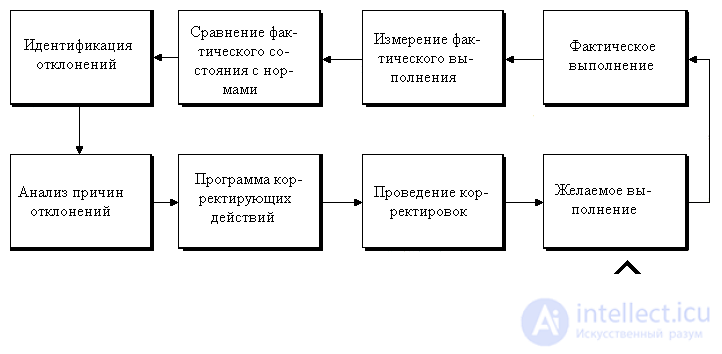Lecture
Control can be defined as a process that ensures the effective achievement of an organization’s goal. The control function includes accounting (collection, processing) and analysis of information on the actual performance of all departments of the organization, comparing them with planned indicators, identifying deviations and analyzing their causes; development of activities to achieve the goals. The appearance of deviations in the activities of the organization from the plan may require urgent decisions, which is carried out through the considered function of coordination and regulation.
Thus, the place and value of control is determined by the fact that it is a way of organizing feedbacks, thanks to which the management body receives information on the progress of its decision.
Control allows you to see the whole real picture of the state of production. And therefore the quality of decisions made and their timely implementation ultimately depend on its effectiveness.
First of all, we distinguish two types of control - strategic (or managerial) and tactical (or administrative).
Strategic, or managerial, control is aimed at solving strategic tasks and is closely connected, of course, with strategic planning * and management. *
Tactical, or administrative, control is designed to systematically monitor the implementation of current tasks, programs, plans.
There are also preliminary, current and final control in organizations.
In the literature there are a number of approaches to the selection of forms of control. For example, there are four forms: control of financial resources, control of material resources, control of human resources and control of information resources.
Some authors distinguish the following forms of control: production control: inventory management, quality control, financial control [].
In addition, there are also such types of control as financial, product quality, pricing, administrative (current) []. There are both functional and resource approaches. Naturally, each technique with a certain approach is legitimate, but, in our opinion, they suffer from some narrowness, one-sidedness. Therefore, along with the above types of control, the following forms of control should be highlighted: financial, production, marketing and product quality control.
Financial control is the basis of general management control and is carried out on the basis of receipt from each unit of financial reporting on standard forms. Financial control covers all aspects of the life of the organization - production, marketing and direct self-government. It includes budgets, cost-effective analysis and analysis of relative indicators and return on investment.
Production control includes six functions:
Marketing control is based on:
Quality control, including novelty, technical level, absence of defects in performance, reliability in operation, is one of the most important criteria for competition, winning and holding positions in the market.
The control process, wherever it is carried out, can be reduced to three stages:
This process is presented in more detail in Fig. 3.15.

Fig. 3. 15. Management feedback loop.
The organization’s control system, in order to be effective, must meet several requirements [].
In accordance with the specified requirements, the control system has been developed, which has the name "Controlling". The essence of this system, like marketing, is the ability to think from the perspective of the client. Controlling as a complete system is focused on identifying all the chances and risks of an organization, both external and internal, that are associated with the achievement of a strategic goal.
Having considered the modern system of organizing the management of the external and internal environment of the organization and management functions * , we can draw conclusions about what constitutes an excellent management. Having surveyed 62 companies known for their excellent management, eight signs were found that were present in each case [].
Although the analysis of the company focused on large companies, but these eight points apply to small firms.
These basic rules will serve both the head of a small firm and the president of a large corporation.
Comments
To leave a comment
Management
Terms: Management